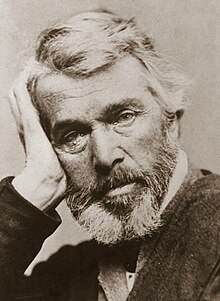
Back توماس كارليل Arabic توماس كارليل ARZ Tomas Karleyl Azerbaijani توماس کارلایل AZB Томас Карлайл Byelorussian Томас Карлайл BE-X-OLD Томас Карлайл Bulgarian টমাস কার্লাইল Bengali/Bangla Thomas Carlyle BS Thomas Carlyle Catalan
Thomas Carlyle | |
|---|---|
 Portrait c. 1865 | |
| Born | 4 December 1795 Ecclefechan, Dumfriesshire, Scotland |
| Died | 5 February 1881 (aged 85) London, England |
| Alma mater | University of Edinburgh |
| Spouse | |
Notable ideas | |
| Signature | |
 | |
Thomas Carlyle (4 December 1795 – 5 February 1881) was a Scottish essayist, historian, and philosopher from the Scottish Lowlands. A leading writer of the Victorian era, he exerted a profound influence on 19th-century art, literature, and philosophy.
Born in Ecclefechan, Dumfriesshire, Scotland, Carlyle attended the University of Edinburgh where he excelled in mathematics, inventing the Carlyle circle. After finishing the arts course, he prepared to become a minister in the Burgher Church while working as a schoolmaster. He quit these and several other endeavours before settling on literature, writing for the Edinburgh Encyclopædia and working as a translator. He found initial success as a disseminator of German literature, then little-known to English readers, through his translations, his Life of Friedrich Schiller (1825), and his review essays for various journals. His first major work was a novel entitled Sartor Resartus (1833–34). After relocating to London, he became famous with his French Revolution (1837), which prompted the collection and reissue of his essays as Miscellanies. Each of his subsequent works, including On Heroes (1841), Past and Present (1843), Cromwell's Letters (1845), Latter-Day Pamphlets (1850), and History of Frederick the Great (1858–65), were highly regarded throughout Europe and North America. He founded the London Library, contributed significantly to the creation of the National Portrait Galleries in London and Scotland,[1] was elected Lord Rector of Edinburgh University in 1865, and received the Pour le Mérite in 1874, among other honours.
Carlyle occupied a central position in Victorian culture, being considered not only, in the words of Ralph Waldo Emerson, the "undoubted head of English letters",[2][3] but a "secular prophet". Posthumously, his reputation suffered as publications by his friend and disciple James Anthony Froude provoked controversy about Carlyle's personal life, particularly his marriage to Jane Welsh Carlyle. His reputation further declined in the 20th century, as the onsets of World War I and World War II brought forth accusations that he was a progenitor of both Prussianism and fascism. Since the 1950s, extensive scholarship in the field of Carlyle Studies has improved his standing, and he is now recognised as "one of the enduring monuments of our literature who, quite simply, cannot be spared."[4]
- ^ "The Great Hall in the Scottish National Portrait Gallery". National Galleries of Scotland. Retrieved 7 August 2022.
The procession starts with the author and historian Thomas Carlyle, who played a significant role in the establishment of the Scottish National Portrait Gallery, and the National Portrait Gallery in London.
- ^ Emerson, Ralph Waldo (1881). "The Literary Work of Thomas Carlyle". Scribner's Monthly. No. 22. p. 92. hdl:2027/uc1.32106009632289.
Mr. Carlyle ... has yet for many years been accepted by competent critics of all shades of opinion as the undoubted head of English letters.
- ^ Stephen 1887, p. 124, "Carlyle during these years had become the acknowledged head of English literature."
- ^ Tennyson 1973, p. 35.
© MMXXIII Rich X Search. We shall prevail. All rights reserved. Rich X Search